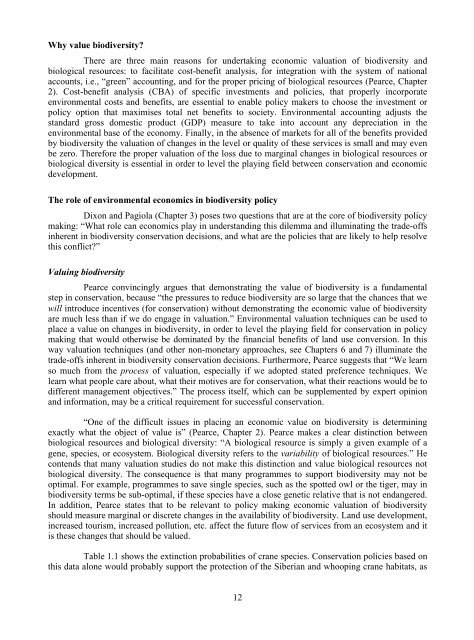Valuation of Biodiversity Benefits (OECD)
Valuation of Biodiversity Benefits (OECD)
Valuation of Biodiversity Benefits (OECD)
- No tags were found...
Create successful ePaper yourself
Turn your PDF publications into a flip-book with our unique Google optimized e-Paper software.
Why value biodiversity?There are three main reasons for undertaking economic valuation <strong>of</strong> biodiversity andbiological resources: to facilitate cost-benefit analysis, for integration with the system <strong>of</strong> nationalaccounts, i.e., “green” accounting, and for the proper pricing <strong>of</strong> biological resources (Pearce, Chapter2). Cost-benefit analysis (CBA) <strong>of</strong> specific investments and policies, that properly incorporateenvironmental costs and benefits, are essential to enable policy makers to choose the investment orpolicy option that maximises total net benefits to society. Environmental accounting adjusts thestandard gross domestic product (GDP) measure to take into account any depreciation in theenvironmental base <strong>of</strong> the economy. Finally, in the absence <strong>of</strong> markets for all <strong>of</strong> the benefits providedby biodiversity the valuation <strong>of</strong> changes in the level or quality <strong>of</strong> these services is small and may evenbe zero. Therefore the proper valuation <strong>of</strong> the loss due to marginal changes in biological resources orbiological diversity is essential in order to level the playing field between conservation and economicdevelopment.The role <strong>of</strong> environmental economics in biodiversity policyDixon and Pagiola (Chapter 3) poses two questions that are at the core <strong>of</strong> biodiversity policymaking: “What role can economics play in understanding this dilemma and illuminating the trade-<strong>of</strong>fsinherent in biodiversity conservation decisions, and what are the policies that are likely to help resolvethis conflict?”Valuing biodiversityPearce convincingly argues that demonstrating the value <strong>of</strong> biodiversity is a fundamentalstep in conservation, because “the pressures to reduce biodiversity are so large that the chances that wewill introduce incentives (for conservation) without demonstrating the economic value <strong>of</strong> biodiversityare much less than if we do engage in valuation.” Environmental valuation techniques can be used toplace a value on changes in biodiversity, in order to level the playing field for conservation in policymaking that would otherwise be dominated by the financial benefits <strong>of</strong> land use conversion. In thisway valuation techniques (and other non-monetary approaches, see Chapters 6 and 7) illuminate thetrade-<strong>of</strong>fs inherent in biodiversity conservation decisions. Furthermore, Pearce suggests that “We learnso much from the process <strong>of</strong> valuation, especially if we adopted stated preference techniques. Welearn what people care about, what their motives are for conservation, what their reactions would be todifferent management objectives.” The process itself, which can be supplemented by expert opinionand information, may be a critical requirement for successful conservation.“One <strong>of</strong> the difficult issues in placing an economic value on biodiversity is determiningexactly what the object <strong>of</strong> value is” (Pearce, Chapter 2). Pearce makes a clear distinction betweenbiological resources and biological diversity: “A biological resource is simply a given example <strong>of</strong> agene, species, or ecosystem. Biological diversity refers to the variability <strong>of</strong> biological resources.” Hecontends that many valuation studies do not make this distinction and value biological resources notbiological diversity. The consequence is that many programmes to support biodiversity may not beoptimal. For example, programmes to save single species, such as the spotted owl or the tiger, may inbiodiversity terms be sub-optimal, if these species have a close genetic relative that is not endangered.In addition, Pearce states that to be relevant to policy making economic valuation <strong>of</strong> biodiversityshould measure marginal or discrete changes in the availability <strong>of</strong> biodiversity. Land use development,increased tourism, increased pollution, etc. affect the future flow <strong>of</strong> services from an ecosystem and itis these changes that should be valued.Table 1.1 shows the extinction probabilities <strong>of</strong> crane species. Conservation policies based onthis data alone would probably support the protection <strong>of</strong> the Siberian and whooping crane habitats, as12












